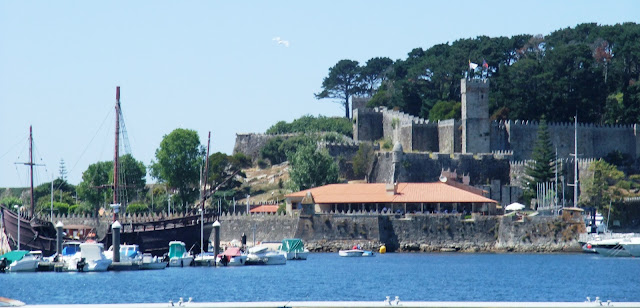Oeiras and Onward
After our sightseeing tour of Lisbon we repaired back to
Oeiras for some R&R and laundry! The pool at the complex was lovely so we
stayed a couple of days longer than originally planned while we decided where
to go next.
Oeiras beach and Castle
We had read in the pilot book about a beautiful anchorage (The
best in Portugal?) under the cliffs at the mouth of the Rio Sado. This was
confirmed by a couple we met at the marina, we were warned that as the area is
a marine reserve there was some confusion as to the areas you were allowed to
anchor in.
Leaving Oeiras we were surprised at the roughness of the
water even though we were in the main channel, the spring ebb was running hard
against the onshore swell and really kicked up a big sea even though we were in
30m of water! Usual story in the morning, little wind but a hooley by mid
afternoon!
We worked our way in to the ‘anchorage’ at Portinho de
Arrabida between the castle on the shore and an offshore sandbank. (A gap of
about 200m) Pretty scary as at anything other than a couple of hours near high
water the waves break over the bank! We inflated the dinghy and went to go
ashore. Landing was difficult, the only
likely place has nowhere to tie the dinghy to, the main beach is roped off for
swimming and everywhere else has a very rocky shoreline.
At Anchor at Portinho de Arrabida
We managed to get alongside close to what was originally the
harbour wall and met a Canadian guy who lived there; he suggested we speak to
the boatman who was ferrying people to the small craft moored close by.
The boatman spoke no English but a little French, one of his
passengers spoke a little English so we deduced that we were not allowed to
anchor as it was a nature reserve and they were trying to protect the sea bed.
We could pick up one of 3 visitors buoys and the only place we were allowed to
land was by the rocky steps we had previously considered too difficult. The
water that was supposed to be ‘crystal clear’ was rather muddy and we couldn’t
see the bottom close in so wading ashore was not on. We bashed against the rocks
several times on our second attempt to go ashore the following morning and gave
up. Pity as it is quite a beautiful spot although there was a lot of rolling
and very windy early evening due to the katabatic winds off the cliffs.
Slightly disappointed at our visit we left after 2 nights to
sail the 30+ miles to Sines, the birthplace of Vasco da Gama.
Entrance to Sines was easy as was the sail, motor at first,
all canvas up then reef before we arrive. (Same as same as!) We were met at the
marina and directed to a berth on the outermost pontoon. The pilot book says
berthing here can be ‘exciting’ they are not kidding! Having had enough
excitement we walked up to the old town.
Trigger fish - Permanent marina residents
Sines is quite a surprise as on arriving it looks a
commercial port, but as you get into the inner harbour, you arrive at the beach with the
castle, palm trees and old town rising in front of you. The industrial areas
fade into the background.
The town is a real hotch potch of old and new, restored and
derelict.
There are some streets with black and white cobbles like Lisbon, here
the designs are nautical – galleons, compass roses, etc –reflecting their
illustrious heritage.
The new promenade along the beach is done in the same
style. But, most of the streets are narrow and very uneven, old ones still have
a gutter in the middle. You really have to watch your step. The houses are
mostly tiny often only one storey and quite colourful although the new ones are
mainly white with terracotta roof tiles.
The castle walls still stand and are open all the time.
Through the castle is now our short cut to town. There is a pub inside in one corner where we
had a drink looking at the walls, trees and turrets. Amazing.
Inside the castle walls - Note the bar in the corner
We have spent a couple of days exploring the town and
visiting the Museum. Sines has been a port since the time of the Phoenicians
and inhabited since time began. Anchored in the bay we could have been in the
same spot as a trading ship millennia ago, a humbling experience.
View from the anchorage
The town still trades on its most famous son, Vasco da Gama.
There is a whole section in the interesting museum dedicated to him, all in Portuguese so
we did not get the best out of it.
Time to move on and face Cabo St Vicente and the tourists of
the Algarve. We have mixed feelings about the Algarve having heard good and bad
reports. We will find out for ourselves soon enough.




















































